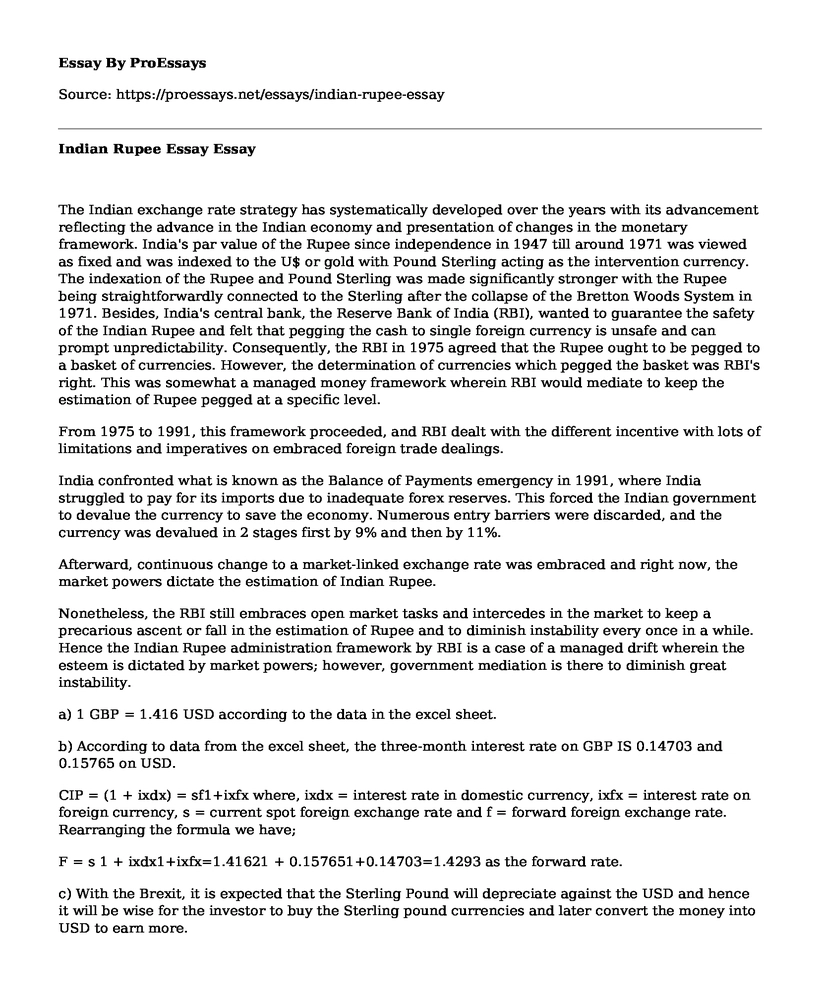The Indian exchange rate strategy has systematically developed over the years with its advancement reflecting the advance in the Indian economy and presentation of changes in the monetary framework. India's par value of the Rupee since independence in 1947 till around 1971 was viewed as fixed and was indexed to the U$ or gold with Pound Sterling acting as the intervention currency. The indexation of the Rupee and Pound Sterling was made significantly stronger with the Rupee being straightforwardly connected to the Sterling after the collapse of the Bretton Woods System in 1971. Besides, India's central bank, the Reserve Bank of India (RBI), wanted to guarantee the safety of the Indian Rupee and felt that pegging the cash to single foreign currency is unsafe and can prompt unpredictability. Consequently, the RBI in 1975 agreed that the Rupee ought to be pegged to a basket of currencies. However, the determination of currencies which pegged the basket was RBI's right. This was somewhat a managed money framework wherein RBI would mediate to keep the estimation of Rupee pegged at a specific level.
From 1975 to 1991, this framework proceeded, and RBI dealt with the different incentive with lots of limitations and imperatives on embraced foreign trade dealings.
India confronted what is known as the Balance of Payments emergency in 1991, where India struggled to pay for its imports due to inadequate forex reserves. This forced the Indian government to devalue the currency to save the economy. Numerous entry barriers were discarded, and the currency was devalued in 2 stages first by 9% and then by 11%.
Afterward, continuous change to a market-linked exchange rate was embraced and right now, the market powers dictate the estimation of Indian Rupee.
Nonetheless, the RBI still embraces open market tasks and intercedes in the market to keep a precarious ascent or fall in the estimation of Rupee and to diminish instability every once in a while. Hence the Indian Rupee administration framework by RBI is a case of a managed drift wherein the esteem is dictated by market powers; however, government mediation is there to diminish great instability.
a) 1 GBP = 1.416 USD according to the data in the excel sheet.
b) According to data from the excel sheet, the three-month interest rate on GBP IS 0.14703 and 0.15765 on USD.
CIP = (1 + ixdx) = sf1+ixfx where, ixdx = interest rate in domestic currency, ixfx = interest rate on foreign currency, s = current spot foreign exchange rate and f = forward foreign exchange rate. Rearranging the formula we have;
F = s 1 + ixdx1+ixfx=1.41621 + 0.157651+0.14703=1.4293 as the forward rate.
c) With the Brexit, it is expected that the Sterling Pound will depreciate against the USD and hence it will be wise for the investor to buy the Sterling pound currencies and later convert the money into USD to earn more.
d) According to data from the excel sheet, the highest and lowest GBP rates against the USD are 1.3193 USD and 1.3087 USD respectively. Therefore, profit = (1.3193 - 1.3087) = 0.01 USD rounded off to 2 dp.
e) According to data from the excel sheet 1 GBP = 8.9176 CNY
Cite this page
Indian Rupee Essay. (2022, May 06). Retrieved from https://proessays.net/essays/indian-rupee-essay
If you are the original author of this essay and no longer wish to have it published on the ProEssays website, please click below to request its removal:
- Article Analysis: Time Value of Money by Louise Fairsave
- Cost Behavior Analysis: Auburn Circular Club
- Issue Analysis Paper Example: School Funding
- Public Relations Campaign Project Paper Example
- Research Paper on Alcoholism and Employment
- Essay Example on Credit Rating Agencies Analyze Firms' Financial Capabilities
- Essay Example on Healthy Competition: Benefits, Types, & Customer Relationships







